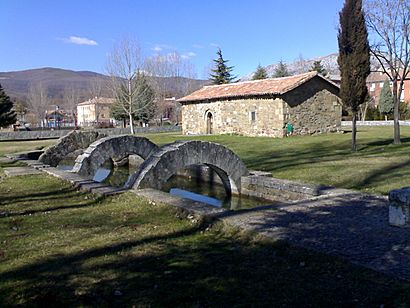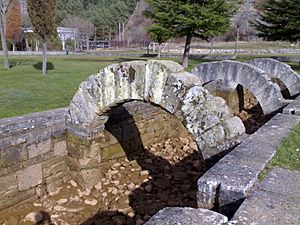Fontes Tamarici facts for kids
Quick facts for kids Fontes Tamarici |
|
|---|---|
| Spanish: Fuentes Tamáricas | |
 |
|
| Year | 1st century BC |
| Type | Public fountain, oracle |
| Medium | Stone |
| Dimensions | 4.5 m × 2 m (15 ft × 6.6 ft) |
| Location | Velilla del Río Carrión, Palencia, Spain |
| 42°49′24″N 4°50′45″W / 42.82333°N 4.84583°W | |
The Fontes Tamarici (pronounced FOHN-tays tah-mah-REE-chee) are three special springs. In Spanish, they are called Fuentes Tamáricas. A famous Roman historian named Pliny the Elder wrote about them. He said they were in an area called classical Cantabria.
Since the 1700s, people have thought these springs are the same as the "La Reana" spring. This spring is located in Velilla del Río Carrión, in Palencia, Spain. Pliny mentioned the springs during the Roman conquest of Cantabria. He noted that the springs often dried up, even when other nearby springs flowed. This was seen as a bad omen, or a sign of bad luck.
History of the Springs
The Tamarici were a tribe that lived in this area. They were part of the larger group called the Cantabri. They lived there from about 300 BC. These people believed that water and sacred springs were very important. They even worshipped them.
We do not know the exact year the Fontes Tamarici were built. But when the Roman Empire took over Cantabria in 19 BC, they found these springs. The Romans were very interested in them. The springs would sometimes stop flowing and then suddenly fill up again. This was often with a loud noise from underground. People at that time respected and worshipped this strange behavior.
It is thought that the springs might have been used for baths or for laundry. They were also likely used for predicting the future. Some people believe the fountain was dedicated to a water god. Predictions were made based on when the water filled or emptied. In the 1200s, a small church called a hermitage was built nearby. It was dedicated to John the Baptist. This was done to make the place Christian and remove any links to older pagan rituals.
Pliny's Story of the Springs

The writings of the naturalist and geographer Pliny the Elder are very important. They help us learn about and find the Tamaric Fountains. In his book, Naturalis Historiae, he talks about the springs' special features:
The sources, too, of the Tamaricus, a river of Cantabria, are considered to possess certain powers of presaging future events: they are three in number, and, separated solely by an interval of eight feet, unite in one channel, and so form a mighty stream. These springs are often dry a dozen times in the day, sometimes as many as twenty, without there being the slightest trace of water there: while, on the other hand, a spring close at hand is flowing abundantly and without intermission. It is considered an evil presage when persons who wish to see these springs find them dry: a circumstance which happened very recently, for example, to Lartius Licinius, who held the office of legatus after his prætorship; for at the end of seven days after his visit he died.
—Pliny the Elder, Naturalis historia, XXXI, 23, trans. John Bostock
Pliny wrote that the springs were thought to predict future events. There were three springs, only eight feet apart. They joined to form a powerful stream. These springs would often dry up many times a day. Meanwhile, a spring very close by would flow all the time. It was seen as a bad sign if someone visited the springs and found them dry.
Pliny tells a story about a man named Lartius Licinius. He was a big supporter of Pliny's work. Licinius visited the springs when they were dry. He died just seven days later, in 70 AD. This made people believe even more in the springs' power to predict bad events.
Doubts About the Springs
Today, many experts are not sure if the La Reana spring is truly the Fontes Tamarici that Pliny described. By 2023, it is highly doubted that they are the same.
A researcher named Fernández Acebo studied old writings and historical records. He believes that connecting La Reana to Pliny's fountain is a mistake. He says it happened because of a wrong understanding of old texts. This mistake was made by a historian named Enrique Flórez in the 1700s.
Flórez had limited information at the time. He mixed up two ancient tribes: the Camarici and the Tamarici. This led to him wrongly identifying the places where they lived. Because Flórez was a respected historian, his mistake was accepted as fact for a long time. This continued until the late 1900s.
Based on this wrong idea, an archaeologist named García Bellido identified La Reana as Pliny's springs. Soon after, the government declared it a "Historical Monument." They wanted to create a tourist attraction in the area. However, Bellido was disappointed. The archaeological digs in 1960 and 1961 found almost no Roman items. Instead, they found mostly medieval things. Bellido honestly admitted this.
He wrote, "The result of both (digging) campaigns results in an insufficient documentation of Roman presence in the spring."
The official declaration as a historical monument made it hard for Bellido to change his mind. He was an honest archaeologist. He did not want to go against the government or upset the local people. So, he left the matter as it was.
Fernández Acebo now suggests that the real Fontes Tamarici might be a different place. It could be the impressive intermittent river called La Fuentona ("The big Fountain"). This is in Ruente, Cantabria, Spain. This location fits Pliny's description much better.
See also
 In Spanish: Fuentes Tamáricas para niños
In Spanish: Fuentes Tamáricas para niños

